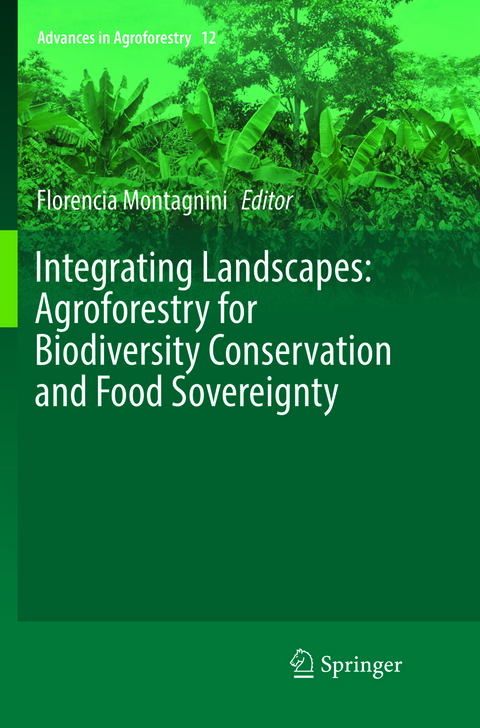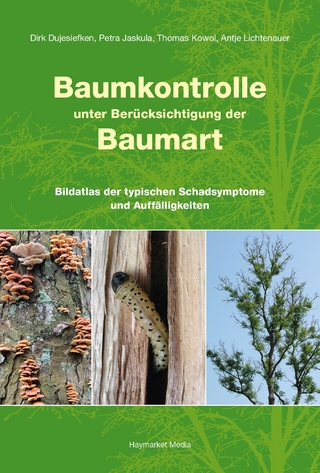
Integrating Landscapes: Agroforestry for Biodiversity Conservation and Food Sovereignty
Springer International Publishing (Verlag)
978-3-319-88765-4 (ISBN)
Agroforestry systems (AFS) are becoming increasingly relevant worldwide as society has come to recognize their multiple roles and services: biodiversity conservation, carbon sequestration, adaptation and mitigation of climate change, restoration of degraded ecosystems, and tools for rural development. This book summarizes advances in agroforestry research and practice and raises questions as to the effectiveness of AFS to solve the development and environmental challenges the world presents us today.
Currently AFS are considered to be a land use that can achieve a compromise among productive and environmental functions. Apparently, AFS can play a significant role in rural development even in the most challenging socioeconomic and ecological conditions, but still there is a lot of work to do to reach these goals. Considerable funding is spent in projects directed to enhancing productivity and sustainability of smallholders forestry and agroforestry practices. These projectsand programs face many questions and challenges related to the integration of traditional knowledge to promote the most suitable systems for each situation; access to markets for AFS products, and scaling up of successful AFS. These complex questions need innovative approaches from varying perspectives and knowledge bases.
This book gathers fresh and novel contributions from a set of Yale University researchers and associates who intend to provide alternative and sometimes departing insights into these pressing questions. The book focuses on the functions that AFS can provide when well designed and implemented: their role in rural development as they can improve food security and sovereignty and contribute to provision of energy needs to the smallholders; and their environmental functions: contribution to biodiversity conservation, to increased connectivity of fragmented landscapes, and adaptation and mitigation of climate change. The chapters present conceptual aspects and case studies ranging from traditional to more modern approaches, from tropical as well as from temperate regions of the world, with examples of the AFS functions mentioned above.
Preface; Florencia Montagnini.- Section 1. Agroforestry challenges and alternatives.- 1. Introduction: Challenges for agroforestry in the new millennium; Florencia Montagnini.- 2. The contribution of agroforestry to Sustainable Development Goal 2: End hunger, achieve food security and improved nutrition, and promote sustainable agriculture; Florencia Montagnini, Ruth Metzel.- 3. Tropical dry forests in multi-functional landscapes: Agroforestry systems for conservation and livelihoods; Irene Montes Londoño.- 4. Agroforestry for the Northeastern United States: Research, practice, and possibilities; Eli Roberts.- 5. Resilience management at landscape level: an approach to tackle social-ecological vulnerability of agroforestry systems; Dardo R. López et al.- Section 2. From subsistence to market oriented systems.- 6. Energy analysis of coffee production systems: Implications for environmental and economic sustainability; Carl F. Jordan.-7. Indigenous successional agroforestry: Integrating the old and new to address food insecurity and deforestation; Asha Bertsch.- 8. Mimicking nature: A review of successional agroforestry systems as an analogue to natural regeneration of secondary forest stands; Katherine Young.- 9. Small-scale Açaí in the global market: Adding value to ensure sustained income for forest farmers in the Amazon Estuary; Leonora Pepper, Lívia De Freitas Navegantes Alves.- 10. Ecological indigenous (EIK) and scientific (ESK) knowledge integration as a tool for sustainable development in indigenous communities. Experience in Misiones, Argentina; Patricia Rocha et al.- 11. Organic yerba mate, Ilex paraguariensis, in association with native species: a sustainable production alternative; Beatriz Eibl et al.- 12. Adapting indigenous agroforestry systems for integrative landscape management and sustainable supply chain development in Napo, Ecuador; ChristopherJarrett et al.- 13. Fuel Alternatives for Developing Countries; Kjell E. Berg.- 14. Specialty crops in temperate agroforestry systems: sustainable management, marketing and promotion for the Midwest region of the U.S.A.; Gregory Ormsby Mori et al.- Section 3. Environmental services in multifunctional landscapes.- 15. Trees on farms for livelihoods, carbon storage and conservation of biodiversity: evidence from Nicaragua on this "invisible" resource; Eduardo Somarriba et al.- 16. Intensive silvopastoral systems: economics and contribution to climate change mitigation and public policies; Julián D. Chará et al.- 17. Enhancing biodiversity in neotropical silvopastoral systems: use of indigenous trees and palms; Zoraida Calle D. et al.- 18. Perennial staple crops and agroforestry for climate change mitigation; Eric Toensmeier.- 19. Carbon sequestration in temperate silvopastoral systems, Argentina; Pablo L. Peri et al.- 20. Conclusions:Lessons learned and pending challenges; Florencia Montagnini.- Index.
| Erscheinungsdatum | 16.02.2019 |
|---|---|
| Reihe/Serie | Advances in Agroforestry |
| Zusatzinfo | XIX, 501 p. 104 illus., 77 illus. in color. |
| Verlagsort | Cham |
| Sprache | englisch |
| Maße | 155 x 235 mm |
| Gewicht | 784 g |
| Themenwelt | Weitere Fachgebiete ► Land- / Forstwirtschaft / Fischerei |
| Schlagworte | Agroforestry research • Biodiversity conservation • Financial benefits of agroforestry • Indigenous knowledge • Integrated landscape management • Payment for environmental services |
| ISBN-10 | 3-319-88765-3 / 3319887653 |
| ISBN-13 | 978-3-319-88765-4 / 9783319887654 |
| Zustand | Neuware |
| Informationen gemäß Produktsicherheitsverordnung (GPSR) | |
| Haben Sie eine Frage zum Produkt? |
aus dem Bereich


